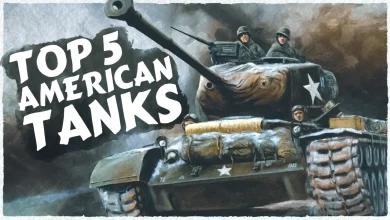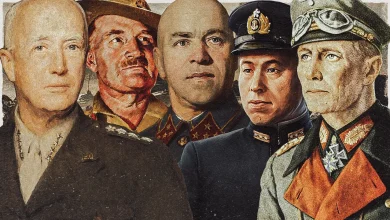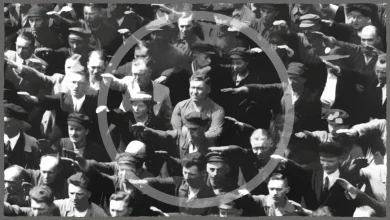Operation Tidal Wave – Blowing Up Hitler’s Gas Station

Before entering World War II, the U.S Army Air Corps, which in 1941 became the Army Air Forces, developed and perfected a particular attack method. It consisted of high-altitude, daylight mass precision bombings of enemy military and industrial structures. This doctrine combined with the British Royal Air Force’s specialty on mass air attack on industrial areas at nighttime.
Both methods eventually evolved into the Allied Combined Bomber Offense, which consisted of a continuous and never-ending bombing of German targets. One of their most important objectives were petroleum production plants and the oil refineries at Ploiești, Rumania.

Although badly damaged in the November 10, 1940 earthquake that shook up the country, the city of Ploiești, 35 miles north of Bucarest, was a significant source of oil for Nazi Germany during the war. The town produced as much as one-third of the Reich’s fuel. The Allies nicknamed the city of Ploiești as Hitler’s Gas Station.
Although the city lay outside the range of Allied bombers from England, there was a possibility it could be reached by B-24 Liberator bombers from a base near the Middle East or North Africa. Because of its importance, Ploiești was one of the most heavily defended targets in all of Europe.
Planning The Attack
In January of 1943, American President Franklin D. Roosevelt, British Prime Minister Winston Churchill, and several other critical advisors for the Allies reunited in the Anfa Hotel for the Casablanca Conference. Their goal was to determine the Allied Strategy in the European Theatre for the next phase of World War II.

In this gathering, Allied top brass decided to bomb the city of Ploiești to hinder the oil supply of the German Luftwaffe, which had been wreaking havoc over Europe. During the planning phase, General Henry “Hap” Arnold delegated the mission, then codenamed Operation Tidal Wave, to Colonel Jacob Smart, a member of his Advisory Council. Colonel Smart was chosen thanks to his involvement in a previous attack on the oil refineries by a small group of B-24 Liberators of the Halverson Project.
In that mission, the bombers faced minimal encounters by the Luftwaffe, so the Allies assumed that with more B-24 bombers, heavier damage could be inflicted in a much shorter time. When tasked with this new Operation, Colonel Smart decided that this surprise attack would be far different from other offensives previously performed by the Allies.
Operation Tidal Wave was straightforward and yet creative. A total of 1,751 Allied airmen aboard 178 B-24 bombers, led by Brigadier General Uzal Ent, would leave their airfield base in Benghazi and fly across the Adriatic Sea and through the Pindus Mountains in Albania.
The mission was split into two groups. Team A consisted of the 376th and 93rd Bomb Groups, led by Colonel Keith Compton. Team B comprised the 98th, 44th, and 389th Bomb Groups, with Colonel John Kane as their leader. The two formations would enter Romania through Yugoslavia and approach the city of Ploiești from the east, flying at a low altitude, under radio silence, and with no fighter support.
Once they made it to the North undetected, they would start a simultaneous surprise aerial strike, hitting the nine Ploiești oil refineries. This strategy would allow them to avoid German radars and achieve the element of surprise. This approach would also minimize the time the bombers would be in the German anti-aircraft guns range.

By the summer of 1943, the five groups chosen for the Operation began a thorough training for low-level missions under the Ninth Air Force’s direction, responsible for planning the Operation. This mission was the largest contribution of American planes on a mission to that date. However, the results would be worth the effort. If Operation Tidal Wave went as expected, the massive aerial assault would cut up to a third of Hitler’s oil refining capacity in only a half-hour.
Defenses
The Luftwaffe’s defenses had been greatly underestimated, much to the misfortune of the Allies. After the B-24 Liberators’ initial attack, Luftwaffe General Alfred Gerstenberg had fortified the defenses around Ploiești.
His defense system, composed of over a hundred high-caliber anti-aircraft guns, and low-caliber guns, turned Ploiești into the most rigid air defense network in all of Europe. Some of the smaller guns were hidden in old cars, haystacks, and even inside mock buildings. Additionally, three Luftwaffe fighter groups, consisting of Messerschmitt Bf 109 fighters and Messerschmitt Bf 110 fighter bombers, were stationed within flight range of Ploiești, awaiting orders in case of attack.

Gerstenberg prepared Ploiești’s defense for several years. Although thorough and optimistic about their creative approach, the Allies only had six weeks to prepare for their attack.
Black Sunday
On the morning of August 1, 1943, 178 B-24 bombers took off from Allied airfields in Benghazi and headed northeast over the Mediterranean sea, towards the city of Ploiești. Operation Tidal Wave had begun.

However, due to their superiors’ radio silence order, problems started almost immediately after takeoff, when a plane was lost due to limited visibility. Shortly after, another B-24 crashed, prompting others to abort the mission. The groups appeared to regain stability as they flew through the Balkan mountains at an altitude of 11,000 feet. However, when the planes began to drop lower, the units became separated. Suddenly, team A flew further ahead of team B.
In another crucial incident, a lead pilot from Team A took a wrong turn and led his formation towards Bucharest rather than Ploiești. Thus, other pilots had to break the radio silence rule to guide him in the right direction. This event made the bombers lose the element of surprise, as Luftwaffe superiors noticed their conversation.

By the time the Allied groups finally arrived in Romania in scattered formations, only 167 of the original 178 bombers had made it to Ploiești. Since the German formations had already been notified of the Allies’ upcoming attack, the bomber fighters started hovering in search of the intruders.

Team A, led by Colonel Compton, began to bombard Ploiești from the south, while Kane’s group, Team B, arrived a bit later and attacked from the North. The attack was dramatic, chaotic, and bloody. Such was the mess that historians also refer to this Operation as Black Sunday.

The Allies instantly received heavy return fire from General Gerstenberg’s aerial defenses, which struck from its smartly concealed anti-aircraft guns. Both teams suffered heavy casualties, and the smoke from the anti-aircraft explosions by the Wave of team A made it difficult for Team B to see. Survivors later reported debris like branches and barbed wire hitting and entering their bombers.
The surviving bombers attempted to flee to the south by themselves or in small groups, all while being followed by Nazi fighters. Some of the planes crashed into Romanian fields or disappeared in the ocean. Others were lucky to land in Allied bases around the area, and some sought sanctuary in Turkey, a neutral region.
The Highest of Honors
Tidal Wave remains the most highly decorated military Operation in American history, with 5 medals of honor being awarded, 3 of them posthumously.
Lt. Col. Addison Baker and his copilot, Major John Jerstad, were posthumously awarded the Medal for their attempt to fly their B-24 higher to allow the crew to bail out. Despite their best intentions, their plan failed.

Pilot Lt. Lloyd Herbert Hughes also received the Medal after his death for crashing his critically-damaged bomber into its target. Col. John Kane, and Col. Leon Johnson, were the only surviving men awarded with the Medal of Honor.

Colonel Smart, the mastermind behind the Operation, spent almost a year as a prisoner of war and ultimately retired from the Army as a four-star general.
A Wave of Failure
Despite the heroism and determination of the American airmen who participated in the mission, Tidal Wave’s results were disappointing.
Only 88 of the 177 B-24 planes made it back to their base in Libya, most of them with severe damage. Operation Tidal Wave claimed the lives of over 300 men, and an additional 108 soldiers were captured.
The attack temporarily hindered almost 4 million tons of Ploieștis oil production, around 46% of their total annual production. Three out of the nine refineries that produced oil for the Germans lost 100% of their production.
However, these losses were only temporary, as the damage was quickly repaired. Within months, the refineries had even outstripped their previous capacity. The Allies’ most crucial target, Astro Romana, was back in production within a few months, while the Concordia Vega was operating at 100% only a month after the attacks.
The city of Ploiești recovered rapidly. The region continued to serve as Hitler’s gas station until the Soviet Union captured it in August of 1944. Because the Germans recuperated in such little time, Operation Tidal Wave is mostly considered a failure.
Although innovative in concept, the Operation was never repeated, and the Allies never again attempted a low-level mission against German air defenses. The only record it set was for the most Medals of Honor awarded in a single Operation.
However, it could be argued that a delay in production, even as brief as this one, was a success for the Allies and ultimately aided towards their eventual victory in 1945.



